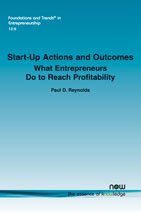Start-up Actions and Outcomes: What Entrepreneurs Do to Reach Profitability
By Paul D. Reynolds, Aston Business School, UK, pauldavidsonreynolds@gmail.com
Abstract
Globally, hundreds of millions enter the firm creation process every year. About a third will actually develop a profitable new firm. Understanding how these successful efforts reach initial profits has been a major challenge for entrepreneurial scholars. A recently developed research protocol has involved systematic collection of data on the start-up activities of representative samples of nascent ventures and tracking their outcomes; a number of Panel Study of Entrepreneurial Dynamics [PSED] projects have been completed. Assembling data from five PSED cohorts in four countries has allowed for attention to the effect of start-up activities on the outcomes of a harmonized sample of 2,500 nascent ventures. There is no difference in outcomes related to the gender of the nascent entrepreneur, a small effect associated with age, and modest impacts associated with educational attainment, work history, and experience with other start-up initiatives. There is a systematic country effect; the U.S. has a lower proportion of profitable new firms than Australia, China, or Sweden. Many aspects of the start-up effort are related to the outcomes. A greater range of start-up activities early in the start-up process is associated with profitability, less terminations, and fewer with a long tenure in the start-up process. Activities emphasizing promotion of the nascent venture, assembling a firm infrastructure, and implementing a production process are associated with initial profitability and fewer terminations. Business planning increases the tendency to quit and reduces the proportion active in the start-up process. It may reduce the time to reach disengagement. Implementing of promotion, infrastructure development, and establishing a production process also reduces the time to reach initial profits. The results have implications for both aspiring entrepreneurs and policy development.
Start-up Actions and Outcomes: What Entrepreneurs Do to Reach Profitability
The primary objective of Start-up Actions and Outcomes: What Entrepreneurs Do to Reach Profitability is to provide a description of the firm creation process based on five harmonized data sets from four countries that track the business creation process. The second objective is to explore the role of start-up activities on the outcomes for these nascent ventures. Outcomes include not only whether they reach profitability or disengage but how long it takes to achieve a resolution. The sooner a start-up team can determine if a nascent venture is profitable or hopeless, the lower the sunk costs.
The presentation begins with a review of the conceptualization of business creation. This is followed by a discussion of assessments of the role of business planning, the start-up activity that has received the most attention in relation to outcomes. A summary of the Panel Study of Entrepreneurial Dynamics (PSED) protocol describes the basis for the five cohort data set. To identify the impact of different background factors and start-up domains on outcomes, two assessments are completed. First, linear additive models are developed using stepwise regression. Second, interactions among factors are identified using a three level decision tree assessment. In both, there are major differences related to the host country and the total amount of start-up activity. To identify the impact of specific start-up domains, the assessments are replicated without measures of total start-up activity. The final section summarizes the major patterns and the implications for those starting new firms, developing public policy, or planning the next stages of research.
